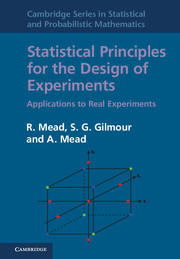Book contents
- Frontmatter
- Contents
- Preface
- Part I Overture
- Part II First subject
- Part III Second subject
- 12 Experimental objectives, treatments and treatment structures
- 13 Factorial structure and particular forms of effects
- 14 Fractional replication
- 15 Incomplete block size for factorial experiments
- 16 Quantitative factors and response functions
- 17 Multifactorial designs for quantitative factors
- 18 Split-unit designs
- Part IV Coda
- References
- Index
18 - Split-unit designs
from Part III - Second subject
Published online by Cambridge University Press: 05 November 2012
- Frontmatter
- Contents
- Preface
- Part I Overture
- Part II First subject
- Part III Second subject
- 12 Experimental objectives, treatments and treatment structures
- 13 Factorial structure and particular forms of effects
- 14 Fractional replication
- 15 Incomplete block size for factorial experiments
- 16 Quantitative factors and response functions
- 17 Multifactorial designs for quantitative factors
- 18 Split-unit designs
- Part IV Coda
- References
- Index
Summary
Preliminary examples
Both of the following examples come from situations where the experimenter designed an experiment without consulting a statistician. When the experimenter came to consult the statistician, with the experimental data, the first problem was to identify the structure of the design and then to provide a suitable analysis.
(a) The first experiment was concerned with the influences on the production of glasshouse tomatoes of differing air and soil temperatures. Eight glasshouse compartments were available, and these were paired in four ‘blocks’. Each compartment contained two large troughs in which the tomatoes were grown and in each half of each trough the soil temperature could be heated to a required level or left unheated. In one compartment of each block the minimum air temperature was kept at 55 °F and in the other the minimum air temperature was 60 °F. In each trough, one half was maintained at the control soil temperature while the other half was at an increased temperature, the increased temperature being 65 °F for one trough, and 75 °F for the other trough. The design layout for one pair of compartments is shown in Figure 18.1. Yields of tomatoes from each half-trough were recorded.
(b) The second experiment was also concerned with heating, this time the heating characteristics of different forms of plastic pot situated in cold frames and of different forms of covers for the frames. Six wooden frames were divided into four quarters and four different forms of pot were allocated to the four quarters randomly in each frame.
- Type
- Chapter
- Information
- Statistical Principles for the Design of ExperimentsApplications to Real Experiments, pp. 475 - 510Publisher: Cambridge University PressPrint publication year: 2012

